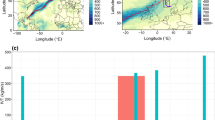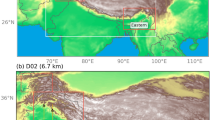Abstract
Inland-penetrating atmospheric rivers (ARs) affect the United States Southwest and significantly contribute to cool season precipitation. In this study, we examine the results from an ensemble of dynamically downscaled simulations from the North American Regional Climate Change Assessment Program (NARCCAP) and their driving general circulation models (GCMs) in order to determine statistically significant changes in the intensity of the cool season ARs impacting Arizona and the associated precipitation. Future greenhouse gas emissions follow the A2 emission scenario from the Intergovernmental Panel on Climate Change Fourth Assessment Report simulations. We find that there is a consistent and clear intensification of the AR-related water vapor transport in both the global and regional simulations which reflects the increase in water vapor content due to warmer atmospheric temperatures, according to the Clausius-Clapeyron relationship. However, the response of AR-related precipitation intensity to increased moisture flux and column-integrated water vapor is weak and no significant changes are projected either by the GCMs or the NARCCAP models. This lack of robust precipitation variations can be explained in part by the absence of meaningful changes in both the large-scale water vapor flux convergence and the maximum positive relative vorticity in the GCMs. Additionally, some global models show a robust decrease in relative humidity which may also be responsible for the projected precipitation patterns.













Similar content being viewed by others
References
Allen M, Ingram W (2002) Constraints on future changes in climate and the hydrologic cycle. Nature 419:224–232
Bao J-W, Michelson SA, Neiman PJ, Ralph FM, Wilczak JM (2006) Interpretation of enhanced integrated water vapor bands associated with extratropical cyclones: Their formation and connection to tropical moisture. Mon Wea Rev 134:1063–1080. doi:10.1175/MWR3123.1
Barnes EA, Polvani L (2013) Response of the midlatitude jets, and of their variability, to increased greenhouse gases in the CMIP5 models. J Clim 26:7117–7135
Bengtsson L, Hodges KI, Keenlyside N (2009) Will extratropical storms intensify in a warmer climate? J Clim 22:2276–2301
Collins WD et al (2006) The community climate system model: CCSM3. J Clim 19:2122–2143
Dee DP et al (2011) The ERA-Interim reanalysis: configuration and performance of the data assimilation system. Q J Roy Meteor Soc 137:553–597
Delcambre SC, Lorenz DJ, Vimont DJ, Martin JE (2013) Diagnosing Northern Hemisphere jet portrayal in 17 CMIP3 global climate models: twentieth-century intermodel variability. J Clim 26:4910–4929
Dettinger MD (2011) Climate change, atmospheric rivers and floods in California: a multimodel analysis of storm frequency and magnitude changes. J Am Water Resour Assoc 47:514–523
Dettinger MD (2013) Atmospheric rivers as drought busters on the U.S. West Coast J Hydrometeor 14:1721–1732
Dettinger MD, Ralph FM, Das T, Neiman PJ, Cayan D (2011) Atmospheric rivers, floods, and the water resources of California. Water 3:455–478
Dominguez F, Rivera ER, Castro CL, Lettenmaier DP (2012) Changes in winter precipitation extremes for the western United States under a warmer climate as simulated by regional climate models. Geophys Res Lett 39:L05803. doi:10.1029/2011GL050762
Emori S, Brown S (2005) Dynamic and thermodynamic changes in mean and extreme precipitation under changed climate. Geophys Res Lett 32:L17706
Flato GM (2005) The third generation coupled global climate model (CGCM3). http://www.ec.gc.ca/ccmac-cccma. Accessed 1 Oct 2014
Gershunov A, Rajagopalan B, Overpeck J, Guirguis K, Cayan D, Hughes M, Dettinger M, Castro C, Schwartz RE, Anderson M, Ray AJ, Barsugli J, Cavazos T, Alexander M (2013) Future climate: projected extremes. In: Garfin G, Jardine A, Merideth R, Black M, LeRoy S (eds) Assessment of Climate Change in the Southwest United States: A Report Prepared for the National Climate Assessment. Southwest Climate Alliance. Island Press, Washington, pp 126–147
GFDL (2004) The new GFDL global atmospheric and land model AM2-LM2: evaluation with prescribed SST simulations. J Clim 17:4641–4673
Gordon C, Cooper C, Senior CA, Banks H, Gregory JM, Johns TC, Mitchell JFB, Wood RA (2000) The simulation of SST, sea ice extents and ocean heat transports in a version of the Hadley Centre coupled model without flux adjustments. Clim Dyn 16:147–168
Grell G, Dudhia J, Stauffer DR (1993) A description of the fifth generation Penn State/NCAR Mesoscale Model (MM5). NCAR Technical Note NCAR/TN-398, 107 pp
Held IM, Soden BJ (2006) Robust responses of the hydrological cycle to global warming. J Clim 19:5686–5699
Hughes M, Mahoney KM, Neiman PJ, Moore BJ, Alexander M, Ralph FM (2014) The landfall and inland penetration of a flood-producing atmospheric river in Arizona. Part II: sensitivity of modeled precipitation to terrain height and atmospheric river orientation. J Hydrometeor 15:1954–1974. doi:10.1175/JHM-D-13-0176.1
Jones R, Hassell D, Hudson D, Wilson S, Jenkins G, Mitchell J (2003) Generating high resolution climate change scenarios using PRECIS. UNDP National Communications Unit Workbook, 34 pp
Juang H, Hong S, Kanamitsu M (1997) The NMC nested regional spectral model: an update. Bull Am Meteor Soc 78:2125–2143
Knippertz P, Martin JE (2007) A Pacific moisture conveyor belt and its relationship to a significant precipitation event in the semiarid southwestern United States. Wea Forecast 22:125–144
Lavers DA, Villarini G, Allan RP, Wood EF, Wade AJ (2012) The detection of atmospheric rivers in atmospheric reanalyses and their links to British winter floods and the large-scale climatic circulation. J Geophys Res 117:D20106. doi:10.1029/2012JD018027
Lavers DA, Allan RP, Villarini G, Lloyd-Hughes B, Brayshaw DJ, Wade AJ (2013) Future changes in atmospheric rivers and their implications for winter flooding in Britain. Environ Res Lett 8:034010. doi:10.1088/1748-9326/8/3/034010
Lenderink G, Van Meijgaard E (2008) Increase in hourly precipitation extremes beyond expectations from temperature changes. Nat Geosci 1:511–514
Mahoney KM, Alexander MA, Scott JD, Barsugli J (2013) High-resolution downscaled simulations of warm-season extreme precipitation events in the Colorado front range under past and future climates. J Clim 26:8671–8689
Mearns LO et al (2007) The North American regional climate change assessment program dataset. National Center for Atmospheric Research Earth System Grid data portal, Boulder
Mearns LO, Gutowski WJ, Jones R, Leung L-Y, McGinnis S, Nunes AMB, Qian Y (2009) A regional climate change assessment program for North America. EOS 90:311–312
Music B, Caya D (2007) Evaluation of the hydrological cycle over the Mississippi River basin as simulated by the Canadian regional climate model (CRCM). J Hydromet 8:969–988
Navarra A, Simoncini V (2010) A guide to empirical orthogonal functions for climate data analysis, 1st edn. Springer, Berlin, p 200
Neiman PJ, Ralph FM, Wick GA, Lundquist J, Dettinger MD (2008) Meteorological characteristics and overland precipitation impacts of atmospheric rivers affecting the west coast of North America based on eight years of SSM/I satellite observations. J Hydrometeor 9:22–47
North GR, Bell TL, Cahalan RF, Moeng FJ (1982) Sampling errors in the estimation of empirical orthogonal functions. Mon Wea Rev 110:699–706
O’Gorman PA, Muller CJ (2010) How closely do changes in surface and column water vapor follow Clausius–Clapeyron scaling in climate change simulations? Environ Res Lett 5:025207. doi:10.1088/1748-9326/5/2/025207
Pall P, Allen MR, Stone DA (2007) Testing the Clausius–Clapeyron constraint on changes in extreme precipitation under CO2 warming. Clim Dyn 28:351–363
Pope VD, Gallani ML, Rowntree PR, Stratton RA (2000) The impact of new physical parameterizations in the Hadley Centre climate model: hadAM3. Clim Dyn 16:123–146
Ralph FM, Dettinger MD (2011) Storms, floods and the science of atmospheric rivers. EOS. Trans Am Geophys. Union 92:265–266
Ralph FM, Neiman PJ, Wick GA (2004) Satellite and CALJET aircraft observations of atmospheric rivers over the eastern North Pacific Ocean during the winter of 1997/98. Mon Wea Rev 132:1721–1745
Rivera ER, Dominguez F, Castro CL (2014) Atmospheric rivers and cool season precipitation events in the Verde River basin of Arizona. J Hydrometeor 15:813–829
Rutz JJ, Steenburgh WJ (2012) Quantifying the role of atmospheric rivers in the interior western United States. Atmos Sci Let 13:257–261
Rutz JJ, Steenburgh WJ, Ralph FM (2014) Climatological characteristics of atmospheric rivers and their inland penetration over the Western United States. Mon Wea Rev 142:905–921
Sheppard PR, Comrie AC, Packin GD, Angersbach K, Hughes MK (2002) The climate of the US Southwest. Clim Res 21:219–238
Skamarock WC, Klemp JB, Dudhia J, Gill DO, Barker DM, Wang W, Powers JG (2005) A description of the Advanced Research WRF version 2. NCAR Technical Note NCAR/TN-468 + STR, 88 pp
Trenberth KE (2011) Changes in precipitation with climate change. Clim Res 47:123–138
Trenberth KE, Dai A, Rasmussen R, Parsons D (2003) The changing character of precipitation. Bull Am Meteor Soc 84:1205–1217
Warner MD, Mass CF, Salathé EP Jr (2015) Changes in winter atmospheric rivers along the North American west coast in CMIP5 climate models. J Hydrometeor 16:118–128
Wehner MF (2013) Very extreme seasonal precipitation in the NARCCAP ensemble: model performance and projections. Clim Dyn 40:59–80
Wick GA, Neiman PJ, Ralph FM (2013) Description and validation of an automated objective technique for identification and characterization of the integrated water vapor signature of atmospheric rivers. IEEE Trans Geosci Remote Sensing 51:2166–2176
Wilks DS (2011) Statistical methods in the atmospheric sciences, 3rd edn. Academic Press, Amsterdam, p 676
Acknowledgments
This work is part of the Ph.D. dissertation of E. R. Rivera at the University of Arizona, Tucson, Arizona. Support for this study has been provided by the National Science Foundation (NSF) Grant 1038938 and the National Aeronautics and Space Administration (NASA) Grant NNX14AD77G. The work of Rivera was also supported by the University of Costa Rica (UCR) Grants OAICE-10-CAB-192-2010, OAICE-AD-05-069-2013, VI-805-B0-065 and VI-805-B5-296. Any opinions, findings, and conclusions or recommendations expressed in this publication are those of the authors and do not necessarily reflect the views of NSF, NASA or UCR. We thank the two anonymous reviewers for their valuable comments and suggestions to improve this manuscript. We also thank Gary Wick from the National Oceanic and Atmospheric Administration (NOAA) for giving us access to the AR detection tool (ARDT) and the NARCCAP program for providing the data used in this paper. NARCCAP is funded by the NSF, the US Department of Energy (DoE), NOAA, and the US Environmental Protection Agency Office of Research and Development (EPA). ECMWF ERA-Interim data have been obtained from the ECMWF Data Server (http://www.ecmwf.int).
Author information
Authors and Affiliations
Corresponding author
Rights and permissions
About this article
Cite this article
Rivera, E.R., Dominguez, F. Projected changes in atmospheric river events in Arizona as simulated by global and regional climate models. Clim Dyn 47, 1673–1691 (2016). https://doi.org/10.1007/s00382-015-2927-0
Received:
Accepted:
Published:
Issue Date:
DOI: https://doi.org/10.1007/s00382-015-2927-0




